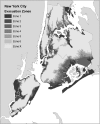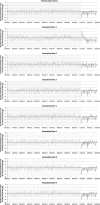Geographic Distribution of Disaster-Specific Emergency Department Use After Hurricane Sandy in New York City
- PMID: 26857616
- PMCID: PMC7112993
- DOI: 10.1017/dmp.2015.190
Geographic Distribution of Disaster-Specific Emergency Department Use After Hurricane Sandy in New York City
Abstract
Objective: We aimed to characterize the geographic distribution of post-Hurricane Sandy emergency department use in administrative flood evacuation zones of New York City.
Methods: Using emergency claims data, we identified significant deviations in emergency department use after Hurricane Sandy. Using time-series analysis, we analyzed the frequency of visits for specific conditions and comorbidities to identify medically vulnerable populations who developed acute postdisaster medical needs.
Results: We found statistically significant decreases in overall post-Sandy emergency department use in New York City but increased utilization in the most vulnerable evacuation zone. In addition to dialysis- and ventilator-dependent patients, we identified that patients who were elderly or homeless or who had diabetes, dementia, cardiac conditions, limitations in mobility, or drug dependence were more likely to visit emergency departments after Hurricane Sandy. Furthermore, patients were more likely to develop drug-resistant infections, require isolation, and present for hypothermia, environmental exposures, or administrative reasons.
Conclusions: Our study identified high-risk populations who developed acute medical and social needs in specific geographic areas after Hurricane Sandy. Our findings can inform coherent and targeted responses to disasters. Early identification of medically vulnerable populations can help to map "hot spots" requiring additional medical and social attention and prioritize resources for areas most impacted by disasters. (Disaster Med Public Health Preparedness. 2016;10:351-361).
Keywords: disaster medicine; emergency department utilization; geographic information systems; vulnerable populations.
Figures




Similar articles
-
Vulnerability of Older Adults in Disasters: Emergency Department Utilization by Geriatric Patients After Hurricane Sandy.Disaster Med Public Health Prep. 2018 Apr;12(2):184-193. doi: 10.1017/dmp.2017.44. Epub 2017 Aug 2. Disaster Med Public Health Prep. 2018. PMID: 28766475
-
Emergency Department Visits for Homelessness or Inadequate Housing in New York City before and after Hurricane Sandy.J Urban Health. 2016 Apr;93(2):331-44. doi: 10.1007/s11524-016-0035-z. J Urban Health. 2016. PMID: 26979519 Free PMC article.
-
Temporal and Spatial Patterns in Utilization of Mental Health Services During and After Hurricane Sandy: Emergency Department and Inpatient Hospitalizations in New York City.Disaster Med Public Health Prep. 2016 Jun;10(3):512-7. doi: 10.1017/dmp.2016.89. Disaster Med Public Health Prep. 2016. PMID: 27292172
-
Hospitals Providing Temporary Emergency Department Services in Alternative Care Settings After Hurricane Sandy.Crit Care Nurs Clin North Am. 2019 Jun;31(2):249-256. doi: 10.1016/j.cnc.2019.02.011. Epub 2019 Apr 5. Crit Care Nurs Clin North Am. 2019. PMID: 31047097 Review.
-
Diabetes and Disasters: Recent Studies and Resources for Preparedness.Curr Diab Rep. 2019 Nov 20;19(11):131. doi: 10.1007/s11892-019-1258-7. Curr Diab Rep. 2019. PMID: 31748930 Review.
Cited by
-
Association Between Hurricane Sandy and Emergency Department Visits in New York City by Age and Cause.Am J Epidemiol. 2021 Oct 1;190(10):2138-2147. doi: 10.1093/aje/kwab127. Am J Epidemiol. 2021. PMID: 33910231 Free PMC article.
-
Index to Predict In-hospital Mortality in Older Adults after Non-traumatic Emergency Department Intubations.West J Emerg Med. 2017 Jun;18(4):690-697. doi: 10.5811/westjem.2017.2.33325. Epub 2017 Apr 19. West J Emerg Med. 2017. PMID: 28611890 Free PMC article.
-
Acute post-disaster medical needs of patients with diabetes: emergency department use in New York City by diabetic adults after Hurricane Sandy.BMJ Open Diabetes Res Care. 2016 Jul 26;4(1):e000248. doi: 10.1136/bmjdrc-2016-000248. eCollection 2016. BMJ Open Diabetes Res Care. 2016. PMID: 27547418 Free PMC article.
-
Global Climate Implications for Homelessness: A Scoping Review.J Urban Health. 2021 Jun;98(3):385-393. doi: 10.1007/s11524-020-00483-1. Epub 2020 Sep 23. J Urban Health. 2021. PMID: 32965555 Free PMC article.
-
A scoping review of geriatric emergency medicine research transparency in diversity, equity, and inclusion reporting.J Am Geriatr Soc. 2024 Nov;72(11):3551-3566. doi: 10.1111/jgs.19052. Epub 2024 Jul 12. J Am Geriatr Soc. 2024. PMID: 38994587
References
MeSH terms
LinkOut - more resources
Full Text Sources
Other Literature Sources
Medical

